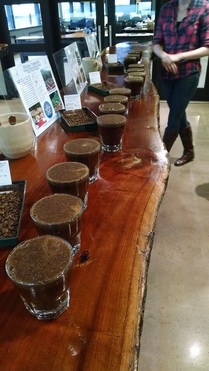 Coffee set up for cupping Coffee set up for cupping Coffee is complicated. Nevermind the endless methods for brewing that bloggers and baristas are constantly tweaking and innovating, the staggering plethora of bean varieties is enough to make your head swim. Like fine wines or craft beer, specialty coffee has an incredible amount to offer if you know where to look and what to taste. So, where am I looking? What am I tasting? Coffee comes from the coffee plant (who woulda thunk?) and that plant can grow in a lot of places; mainly South American, Central America, Africa and many Southeast Asian countries. All of these locations have different soils, different climates and ever-changing elevations along with a multitude of other variables that differ not only country to country but in between farms only a few miles apart. This is the biggest reason one coffee will taste differently than another. Generally speaking, coffees from Central and South America are more breakfast-y; simple, mild and full of nuttiness, floral notes and usually sweet and easy to drink. Coffees from African countries are often more vibrant, ranging in bright florals and citrus to juicy berries and dark fruits. Southeast Asian countries produce beans with more denser profiles, and often carry a lot of earthiness and dark chocolate notes with them. Of course, there are always glorious exceptions to these generalizations. For example, our own Colombian Asojardin displays incredibly sweet strawberry and juicy fruit flavors uncharacteristic of many more nutty and chocolaty Colombian brews. Geography isn't the only thing that dictates a coffee's flavor. How the beans are picked and processed determines a lot of the final product. Coffee needs to be fermented and washed to be able to be roasted and served, and there are a few ways to do this. 'Dry' or 'natural' processed coffees are left to ferment in the dried coffee cherries themselves before being pulped and washed and dried again. These types of coffees can often be more inconsistent because the quality of the seed is hidden by the fruit as it is processed, but the procedure results in beans with a much denser, juicier flavor and mouthfeel. Beans that have been 'wet' processed are pulped first and then fermented in big tanks that allow for more hands on control and offer greater consistency. These types of coffees are much more clean tasting and are generally more delicate and vibrant. Personally, I've always been a sucker for natural processed African coffees, who doesn't want to drink a cup of coffee that tastes like blueberry pie? Now, when we talk about what a coffee tastes like and start rattling off things like pie or orange peel or marzipan, they aren't necessarily these giant, in your face flavors that come from chomping into a fruit or adding some syrup or artificial flavoring. Rather, they are more suggestions that help describe how the coffee tastes as a coffee. Just like how a sommeliere would describe a wine or a brew master would describe a beer, baristas will describe the profile of a coffee the best way they can verbally to help a customer or fellow taster understand how the coffee displays itself to the senses. It is still coffee, but this is how Coffee A is different than Coffee B. Is this a lot of information? Yes. Is it overwhelming? Probably. How am I supposed to make sense of it? Taste coffee. Work your way backwards and make your own observations. If you liked one coffee, ask yourself 'why?'. Ask the barista about the coffee, read its flavor profile and where it came from. Ask the person next to you what they tasted, did you taste the same thing? Do the same if you find coffees you don't like, what qualities made it less appealing? Identify characteristics in your own words and ideas. Don't let someone tell you that you've tasted something incorrectly or even differently, but understand how different people can approach the same flavors differently when verbalized. Coffee tasting can become very social and incredibly informative even in a casual setting and it will always make things clearer at the end of the day. Everyone is always learning, even the most experience baristas and professional tasters will always keep and open mind about the endless profiles a coffee can offer That being said, I still have a personal belief that the best coffees are fine enough that they don't need to be fussed over. As long as you enjoy the cup in your hand and it's good, well then that's the whole point. Sit back, look out the window and sip. Now, isn't that nice? Stay cool good people!
2 Comments
Stephen
7/13/2016 08:32:35 am
Beautiful summary of coffee origins and flavor profiles. Been working in coffee for a few years and I still managed to learn something from your blog entry. That's the magic and allure of coffee. Look forward to tasting the new Ethiopian Sidamo single origin next week!
Reply
Leave a Reply. |
AuthorHayden Kaye is our Master Roaster and head of the Say Interesting Stuff department. Archives
December 2017
Categories |

 RSS Feed
RSS Feed